Frank Roosevelt at Harvard
(And what became of him later)
Author, John T. Bethell
(Editor’s Note. This superb article detailing FDR’s complicated relationship with Harvard, and Harvard’s oft-strained relationship with FDR, was first published in the November-December 1996 issue of Harvard Magazine. It’s reprinted here in updated form with new illustrations, with the kind permission of the author.)
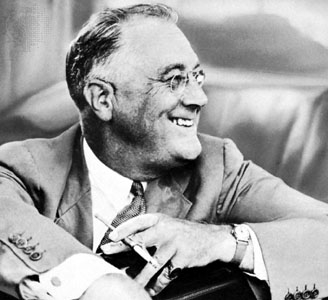
Even adversaries admired his way with words, and the “wise sauciness” – in Felix Frankfurter’s phrase – with which he disarmed his critics. His speech at the 1936 Harvard Tercentenary was a famous example. “This meeting is being held,” he began,
In pursuance of an adjournment expressly taken one hundred years ago on the motion of Josiah Quincy. At that time many of the alumni of Harvard were sorely troubled concerning the state of the nation. Andrew Jackson was President. On the 250th anniversary of the founding of Harvard College, many alumni again were sorely troubled. Grover Cleveland was President. Now, on the three hundredth anniversary, I am President.
He cherished his Harvard connections. In the spring of 1934, when pending legislation seemed likely to keep him from attending his thirtieth reunion, he put on a White House reception for most of the class of 1904. Before attending the Fly Club’s annual dinner the following winter, he wrote Jimmy O’Brien, still the janitor of the residence hall where he’d lived as an undergraduate, inviting him to stop by the clubhouse and say hello. In the presidential yacht, Sequoia, he visited Harvard’s rowing camp at Ledyard, Connecticut, where his freshman son, Franklin Jr., was in training. The next spring he entertained two dozen Harvard oarsmen at a White House dinner.
Love it he might, but Harvard did not always love him back
His enthusiasm was infectious. As a senior at Groton, his son James wanted to go his own way and attend some other college. His father provisionally agreed, James later recalled, but then began talking “hypnotically” about the Crimson, the Fly Club, the Pudding, and his Harvard friendships. James became the fifteenth Roosevelt to enroll at Harvard; many more were to come.
Love it he might, but Harvard did not always love him back. Then President Abbott Lawrence Lowell was rude to him when the Tercentenary exercises were being planned. When he first ran for president, a straw vote held by the Harvard Crimson showed a three-to-one preference for Herbert Hoover. Four years later a Crimson editorial called the president – a former Crimson Editor himself – “a traitor to his fine education.” In irate letters to newspapers and the Harvard Alumni Bulletin, many older Harvard men took the same line.
Yet he was not without honor at Harvard. At the age of 35 he was elected to the Board of Overseers. In 1929, when he was governor of New York, he was elected chief marshal at Commencement. He gave the Phi Beta Kappa Oration, received an honorary degree, and spoke at the afternoon meeting of the alumni. And in 1936, as the nation’s chief executive, he spoke at the Tercentenary exercises.
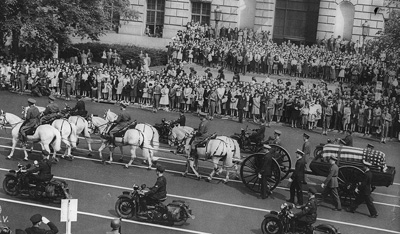
The President’s funeral cortege on Pennsylvania Avenue
Two days after his death on April 12, 1945, mourners jammed the Memorial Church for a service led by Willard Sperry, dean of the Divinity School. “We have lost one of our own members,” said Sperry. “It would be presumptuous to say that elsewhere there is no sorrow like our sorrow. But our sorrow is touched with a humble and proper pride that this society was one of the shaping forces which fitted him for his duty and his destiny.
“He will live in the memory of generations to come,” said the dean, “as one with whom his own time had dealt, if not unfairly, at least austerely. He is a casualty of these costly years of war.”
A fortnight later the Alumni Bulletin published tributes from five distinguished alumni. Older readers contributed reminiscences of his undergraduate days. But the surprising fact is that no lasting memorial to Franklin Delano Roosevelt was ever established at Harvard. [Until now, that is… Ed.]
The institution dealt less austerely with the Harvard-educated presidents who preceded and followed him. The name of Theodore Roosevelt, class of 1880, LL.D. ’02, is cut in stone on the 1880 Gate, outside Lamont Library, and carried on by the library’s Theodore Roosevelt Collection. When John F. Kennedy ’40 was assassinated, Harvard’s school of public administration was renamed in his honor. But no Franklin D. Roosevelt Center, no Roosevelt chair of political science, no Roosevelt lectureships, scholarships, or fellowships memorialize the most famous American of his time, a man who overcame severe physical disability and led his nation and its allies through the most desperate days of the twentieth century. Only a modest plaque marks his old rooms in Westmorly Court.
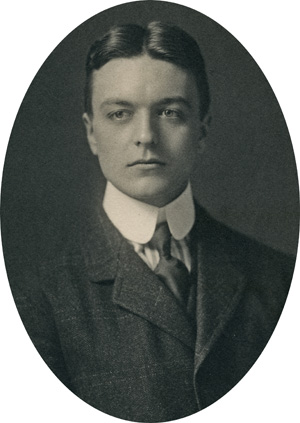
Lathrop Brown, FDR’s Groton chum and Harvard room mate
With its manorial façade, diamond-leaded windows, and oak wainscoting, Westmorly was the most ornate of the privately owned residence halls that lined Harvard’s “Gold Coast.” On Bow Street, opposite Saint Paul’s Church, the building was new in the fall of 1900, when Franklin Roosevelt and Lathrop Brown moved in as freshmen. In the fashion of the day, they decorated the walls of their first-floor suite with school pennants and banners, team pictures, beer steins, and social invitations. The roommates would stay there four years.
Frank Roosevelt and “Jake” Brown, both New Yorkers, had become close friends as students at Groton School. Frank’s Groton career had been unexceptional, but his teachers liked him. He loved to sail and had thought of going to the Naval Academy, but he applied to Harvard at the behest of his father, who had studied law there. Frank’s best college recommendation came from the Reverend Sherrard Billings, who taught Latin, led the choir, coached football, and shepherded the Groton Missionary Society. Billings had been a Harvard classmate of Theodore Roosevelt, A.B. 1880, governor of New York, Spanish War hero, and Frank Roosevelt’s fifth cousin. Writing in May 1900, he advised College officials that:
F.D. Roosevelt is a fellow of exceptional ability and high character. He is mature in his aims and will get a great deal from his courses. He hopes to go into public life, and will shape his work at Cambridge with that end in view. I expect him to be a very useful member of society at Harvard.
Roosevelt and Brown were among 18 Grotonians in the entering class of 1904, which initially had 537 members. A slender six-footer with patrician features and an engaging smile, Frank Roosevelt had begun wearing pince-nez glasses like his famous cousin TR’s. He was so-so at golf, so-so at tennis, and too light for football, TR’s favorite contact sport and the one that mattered most in the turn-of-the-century culture of masculinity. With 150 others Frank tried out for freshman football, but was cut and assigned to the Missing Links, lightest of eight intramural “scrub” teams. His teammates elected him captain. “It is the only [team] composed wholly of Freshmen,” he wrote to his parents, “and I am the only Freshman Captain.”
Having done well enough on his entrance exams to earn sophomore standing, Frank took six courses per term, the maximum number permitted, in order to meet the requirements for the A.B. in three years (a practice followed by more than a third of the undergraduates of the time). He majored in history and got “gentleman’s C’s”-worth high B’s by today’s standards-in almost all his courses.
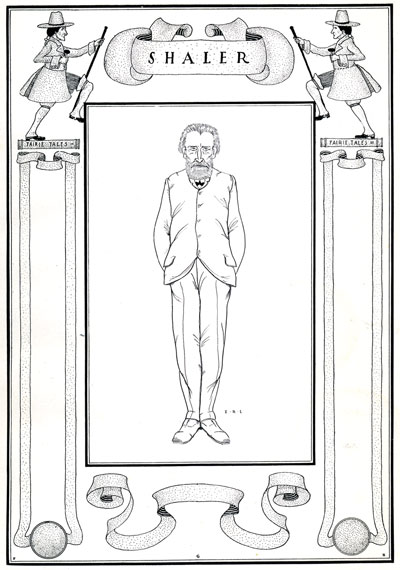
Famed geologist and Harvard Professor Nathaniel Shaler, as seen in a caricature now hanging in the FDR Suite.
His teachers in history and government classes included Edward Channing, Archibald Cary Coolidge, Silas Macvane, Hiram Bingham (then a doctoral student, later the discoverer of Machu Picchu), and Abbott Lawrence Lowell. His instructors in public-speaking courses were Irvah Winter and assistant professor George Pierce Baker. Le Baron Russell Briggs, George Lyman Kittredge, Pierre la Rose, and Barrett Wendell were among his English teachers. Twice he took undemanding geology courses given by the colorful Nathaniel Southgate Shaler, dean of the Lawrence Scientific School. In his third year he took Fine Arts 4 (medieval and Renaissance art) and enrolled in Josiah Royce’s Philosophy 1a. He soon dropped it. “The appeal of systematic or abstract thought,” one biographer has observed, “remained a mystery to Franklin Roosevelt all his life.” 1
Frank Roosevelt and Jake Brown were probably there when President Charles William Eliot spoke at a Sanders Theatre reception for incoming students in October 1900. “It is a common error,” Eliot told the newcomers, “to suppose that the men of this University live in rooms the walls of which are covered with embossed leather; that they have at hand every luxury of modern life. As a matter of fact, there are but few such. The great majority are of moderate means; and it is this diversity of condition that makes the experience of meeting men here so valuable.”
Frank Roosevelt had already declared his intention of acquiring “a large acquaintance,” but it would not be as diverse as President Eliot might have wished. His freshman social life revolved around luncheons, teas, dinners, and dances in Boston and Cambridge. In College affairs he was resolved to be “always active.” He competed (at first unsuccessfully) for the Crimson news board. He sang with the Freshman Glee Club and became its secretary. Though the Hyde Park side of the Roosevelt family normally voted Democratic, he joined the Republican Club to support his Oyster Bay cousin Theodore, President William McKinley’s running mate in the election of 1900. In red caps and gowns, Frank and most of the freshman class joined a torchlight parade into Boston to celebrate the Republican victory in November. Sporting his pince-nez and spouting “Bully!”, Frank seemed to some of his classmates to be trading too much on familial ties. A few started calling him “Kermit,” after one of the Rough Rider’s preadolescent sons. 2

FDR his senior year at Harvard
Frank had been at Harvard for less than a month when his 72-year-old father had a heart attack. James Roosevelt had been ill with heart trouble for 10 years. His attack came two days after news of a scandal involving the erratic “Taddy” Roosevelt, James’s grandson by his first marriage. Taddy had been a year ahead of Frank at Groton. He had great expectations: his mother had come from the wealthiest family in America, the Astors. After a troubled freshman year at Harvard, Taddy married a New York prostitute and rented a West Side apartment, replete with servants. His father found out and broke up the household. Perhaps hoping to embarrass TR, someone tipped off reporters. The headlines didn’t hurt TR’s candidacy, but they were too much for James Roosevelt. In late November he had another attack. A few days later Frank got a telegram from his mother, Sara Delano Roosevelt, summoning him to New York. He went immediately and was there when his father died on December 8. “I regret to tell you of the death of my Father, Mr. James Roosevelt,” Frank wrote to Le Baron Russell Briggs, dean of the College:
As my Mother is all alone and as the end of the term is so near, I feel sure that you will not mind my staying at home with her. Also I should have to be here on Dec. 20th for some legal matter and I think I can make up during the holidays the work I am losing now. I shall be in Cambridge however on Wednesday next and if you desire to see me that day I can go to see you. I know you will understand that I am staying away merely for my Mother’s sake and hope to have the work made up when we return early in January.
Believe me
Sincerely yours,
Franklin D. Roosevelt
Frank was the only child of the marriage and was close to both parents. He and his mother spent a bleak Christmas holiday at Springwood, the family estate in Hyde Park, and Frank returned to Harvard on January 3. The conventional six-month interval of deep mourning curtailed his social activities. He did not make the Crimson when freshman candidates were elected in February, but he entered the spring competition and was one of five who survived it.
His big break came in April, when his cousin, now vice president, visited Boston. Frank reached TR at Professor Lowell’s house and learned that he was speaking at Lowell’s constitutional government class the next day. To avoid attracting a crowd, Lowell had kept it quiet. Frank, who was taking the course, wrote a news item for the Crimson. To Lowell’s displeasure, a crowd of 2,000 was outside the lecture hall the next morning.
Frank and another Oyster Bay cousin, Theodore Robinson ’04, went out for freshman crew that spring. More than 200 students rowed as aliates of the Newell and Weld boat clubs, which competed for seats in the freshman and varsity boats. Frank hadn’t rowed before, but was good enough to stroke Newell’s third boat. In the final club race of the year his crew came from behind to nip Weld’s by three feet. This was Frank’s last hurrah in intramural sports. As an upperclassman he would put most of his energy into the Crimson. What extracurricular time he had left went into club life and social-service activities.
His father’s death had tightened the already close bonds between Frank and his mother. The family usually summered on Campobello Island, east of the Maine-New Brunswick border, but in the summer of 1901, after Frank’s freshman year, neither he nor his mother wanted to be there without James. Instead they took ship for Europe, accompanied by cousin Teddy Robinson. On the return voyage, as their liner passed the Nantucket lightship, they learned that President McKinley had died of an assassin’s gunshot. At 43, TR was now in the White House.
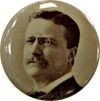
A TR Campaign button, from a scrapbook in the Harvard Archives
The new president was interested in his cousin Franklin. He had encouraged him during his years at Groton and Harvard; in 1905 he would give the bride away at the wedding of Franklin and Eleanor Roosevelt. “I’m so fond of that boy, I’d be shot for him,” he once told Sara Delano Roosevelt. The admiration was mutual. In letters to her son, Sara referred to TR as “your noble kinsman.” Exposure to his ebullient relative always quickened Frank’s political hopes. But as a second-year student at Harvard, he hoped most of all to follow TR as a member of the Porcellian Club.
The Porcellian was the loftiest of Harvard’s “final” clubs. The selection process was rigidly hierarchical. First you had to get into the Institute of 1770, the oldest and largest club. If you were among the first 70 or 80 of the 100 sophomores accepted, you were taken into Delta Kappa Epsilon fraternity (“the Dickey”). Then you might join a “waiting” club, and at last a final club like Porcellian or A.D. Your chances improved if you were a “legacy,” i.e., related to a member.
By Christmas of 1901 the Institute of 1770 had elected 50 men. Frank Roosevelt wasn’t one of them. His anxious thoughts were diverted by an invitation to the social event of the season-17-year-old Alice Roosevelt’s coming-out party at the White House. Two days after Christmas, Frank wrote Dean Briggs,
I have been asked to a dance at the White House in Washington on Friday January 3rd. As I have only three recitations on Friday, and none on Saturday, do you think I might go to it? It would be very kind of you to let me know about it.
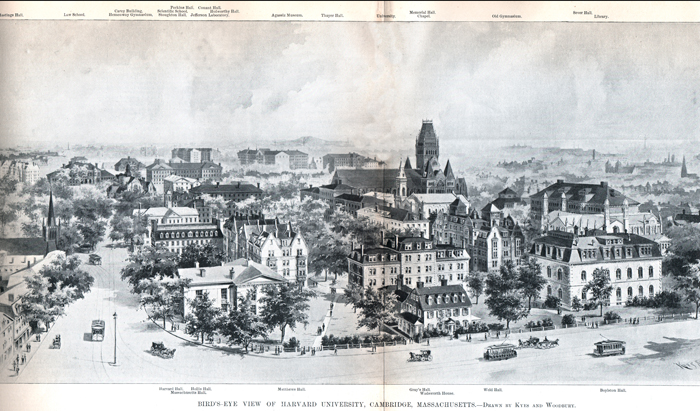
Harvard, as FDR knew it, from a Harper’s Magazine Article now hanging in the Suite
Frank spent three days in Washington. He had tea at the White House and returned for a private talk with TR. He enjoyed the dance, reporting to his mother that “The Washington people weren’t in it with the New Yorkers & from start to finish it was glorious.” Returning to Cambridge, he found he had made the Institute and the Dickey. Then came the blow. Despite his ties to TR, despite the fact that James Roosevelt had been an honorary member, and even though five of the 16 undergraduate members were Grotonians, Frank was not among the eight sophomores elected to the Porcellian.
Lathrop Brown, Frank’s roommate, would later write that “his not ‘making’ the Porcellian meant only that “he was free of any restraining influences of a lot of delightful people who thought that the world belonged to them and who did not want to change anything in it.” Frank settled for membership in the Fly Club. He joined the Signet Society, then and now a haven for students interested in the arts, and the Memorial Society, dedicated to the preservation of Harvard history. He served as librarian of the Fly, the Hasty Pudding Club, and the newly opened Harvard Union, and began buying new and rare books for their shelves and his own.
His resolve to be “always active” was reflected by memberships in the Social Service Society, the St. Paul’s Society, the Political Club, the Yacht Club. He was even an usher and cheerleader at football games. But his core activity was the Crimson. He became an assistant managing editor in the fall of 1902, and managing editor in January 1903. He would complete his degree requirements in another four months, but the presidency was his if he wished to stay on. In order to do so he decided to take more economics and history courses as a graduate student.
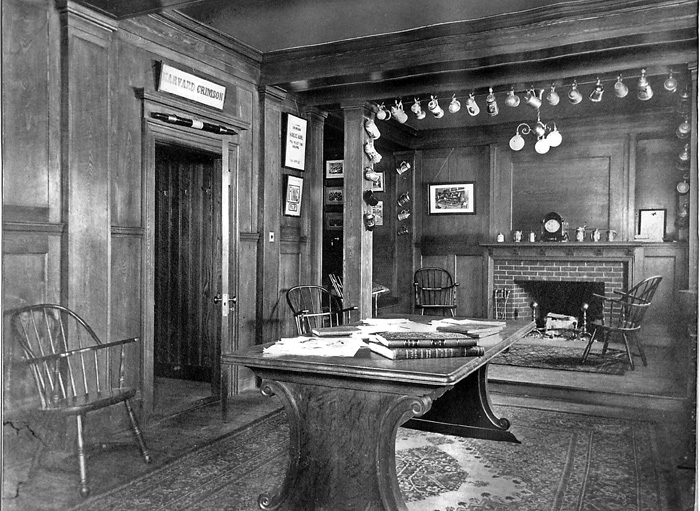
This picture of the Crimson’s sanctum still hangs in FDR’s old childhood bedroom at Hyde Park. The room, now destroyed, was in the former Harvard Union, now the Barker Center.
Some of his Crimson staffers would recall his leadership as no better than competent. Managing editor Walter Russell Bowie ’04, who later became dean of Union Theological Seminary, was more positive. “He had a force of personality which was latent,” said Bowie, “and which subsequent occasions would call out. He liked people, and he made them instinctively like him. Moreover, in his geniality there was a kind of frictionless command.”
That fall’s top stories included the opening of the Germanic Museum, the bequest of millions to Harvard from the estate of Gordon McKay, the completion of Harvard Stadium, and the shortcomings of the football team. An industrious editorial writer, Frank tried to spur on the team (its manager was his roommate). Certain linemen, he declared in one of his editorials, were “of a spirit that will not awake till the team is in a desperate crisis, and goes to sleep again when the crisis is fancied to be past.” He campaigned for wider boardwalks in the muddy Yard, and (successfully) for better fire apparatus and the installation of fire escapes in Yard dormitories. He stepped down as Crimson president in February, and Russell Bowie succeeded him.
By then Frank was thinking about life after Harvard. He had run unsuccessfully for class marshal, finishing fourth in a field of six. (The clubs, he thought, had conspired to elect their own three-man slate.) He then ran for class committee chairman and chalked up an electoral victory. Now he had to choose a law school. He had meant to attend Harvard Law, but his mother wanted him closer to home and was urging him to enroll at Columbia.
To his mother’s dismay, he intended to marry. He and Eleanor Roosevelt, TR’s “favorite niece,” had been distantly acquainted since childhood. They had been seeing each other regularly since November 1902, when they met at the New York Horse Show. Eleanor visited Frank and his mother at Campobello the following fall. In November she was his guest at the Harvard-Yale football game. The next day they went walking in Groton and Frank proposed. He was then 21; Eleanor was 18.
He broke the news to his mother at Thanksgiving. She first asked that the engagement be kept secret for a year. Later she told Frank that she would be renting a Boston apartment that winter, as she had for the past two years. Frank opposed this extension of motherly oversight. As an alternative he suggested they take a five-week winter cruise to the West Indies, with Lathrop Brown as their guest. Sara acquiesced. The separation from Eleanor did not cool Frank’s ardor. Sara tried vainly to get him a post as ambassadorial secretary at the Court of St. James’s, where both his father and half-brother had served. In time she became reconciled to the marriage, but she also contrived to retain a controlling interest in her son’s personal life.

One picture’s worth a thousand words. FDR, Sara and Eleanor during Franklin’s vice-presidential run, 1920
Frank was graduated from Harvard on June 29. As class committee chairman he got to sit on the Sanders Theatre stage. Sara and Eleanor were in the audience. The class orator was Arthur Ballantine, a man Frank had beaten out for the presidency of the Crimson. “Our freedom must be made a means of service,” declared Ballantine. “Some, catching a bit of the spirit of our brothers Phillips, Sumner, and Roosevelt, will find their chance in the field of politics and social reform. Others, perhaps, may help to lift American literature back to that high plane to which it was once led by a Cambridge group. Wherever we serve, the message of this ancient University is clear: we are to stand for absolute freedom of thought.” The Roosevelt he had in mind was, of course, TR. But FDR would find his chance when it came.
In the years ahead he would prove a remarkably loyal alumnus. He regularly attended Harvard Club dinners in New York, Boston, and Washington. Until he was stricken with polio he rarely missed a Harvard-Yale football game. He returned for reunions, and for Fly Club and Crimson dinners. In 1917 he was elected to the Board of Overseers.
At that point his political star was rising. The similarity of its course to TR’s had been noticed. Like TR, Franklin had gone from Harvard to Columbia Law School. 3 At the age of 28, after a desultory four years of private practice, he ran on the Democratic slate for the New York senate. Making four to six speeches a day, he won a seat that had been Republican property for almost three decades. While still in his twenties TR had served three terms in the New York state assembly. FDR won reelection in 1912, and was named assistant secretary of the navy the next year. TR had held that post and gone on to become the governor of New York. Democratic strategists were now talking about running FDR for the governorship.
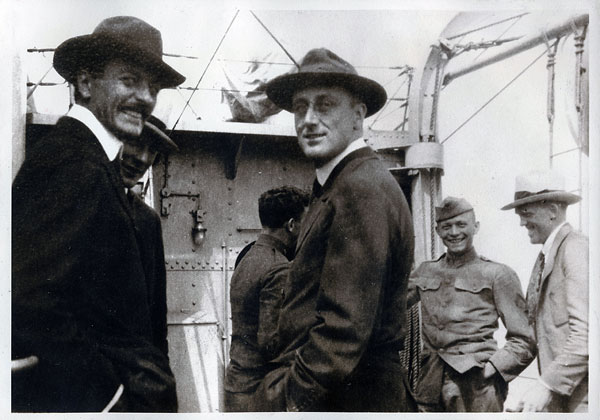
Lathrop Brown and FDR on an unnamed vessel during FDR’s Navy Secretary Days. This picture, previously unknown, as given to the FDR Suite by Lathrop’s granddaughter Pam Grossman.
In his run for Overseer he made a strong showing. Under the system used at the time, Harvard degree-holders initially chose from a field of 20 candidates. In 1917 they included the governor of New Hampshire, the police commissioner of New York City, a justice of the New Jersey supreme court, the Episcopal bishop of Pennsylvania, and a former army chief of staff. Alumni attending Commencement then elected five Overseers from a slate made up of the 10 leading vote-getters. At 35, FDR was the youngest candidate in the field. He placed third in both rounds of balloting (behind Major General Leonard Wood, M.D. 1884, an ex-Rough Rider who would contend for the Republican presidential nomination in 1920, and New York police commissioner Arthur Woods, A.B. 1892). He attended that year’s Commencement exercises and was fêted by classmates at a reception at the Harvard Club of Boston.
But he would have limited time for Harvard affairs. The nation was now at war. After the armistice FDR would be drawn into the inner game of New York politics. In 1920 he spoke at the Democratic nominating convention, making a seconding speech for New York governor Al Smith. When Smith stepped aside to break an extended deadlock, convention-floor horse-trading left FDR as the running mate of Ohio governor James Cox. “His is a name to be conjured with in American politics,” proclaimed an Ohio delegate: “Franklin D. Roosevelt!”

In the spirit of TR – who had died suddenly, at 60, the previous year – Cox and Roosevelt campaigned strenuously. So did TR’s eldest son, Theodore Roosevelt Jr. ’09. He had supported General Leonard Wood at the Republican convention. Now he stalked FDR on the campaign trail. “He is a maverick, [who] does not have the brand of our family,” Ted Jr. told a troop of Rough Riders in Wyoming. In November American voters cast a massive vote of no confidence in the idealistic internationalism of Woodrow Wilson and his would-be successors. The Republican ticket of Warren Harding and Calvin Coolidge got more than 16 million votes; Cox and FDR got just 9 million.
The following August, while vacationing at Campobello, FDR was stricken with polio. His paralysis was severe and agonizingly painful. The remoteness of “Campo” made matters worse. A local doctor from Lubec, Maine, was brought over by motorboat the next day. He diagnosed FDR’s ailment as a bad cold. Dr. W. W. Keen, a venerable Philadelphia physician, was persuaded to motor up from Bar Harbor. He arrived two days later and concluded that the paralysis had been caused by a blood clot or spinal lesion. 4 FDR’s uncle Frederic Delano located a specialist: Dr. Robert Lovett, A.B. 1881, professor of orthopedic surgery at Harvard Medical School and chairman of the Harvard Infantile Paralysis Commission. Two weeks after the onset of FDR’s illness, Lovett arrived at Campobello for a consultation. He quickly diagnosed the disease as poliomyelitis.
Three more weeks passed before FDR could be taken to New York via small boat and private railroad car. For six weeks he was hospitalized. Another six months would pass before he could leave his bed and try to hold himself up with crutches. But his ordeal as a recovering polio patient would be unending.
His calamitous illness was the defining event in FDR’s life. Before his affliction with polio he was viewed by many who knew him as cocky, self-absorbed, superficial, a bit of a playboy, a political lightweight cashing in on his family name. His infirmity and his arduous rehabilitation changed him physically and mentally. He gained a new empathy with those whose lives had been ill-favored. Suffering toughened his character and stiffened his political will. His unquenchable optimism, his refusal to regard himself as an invalid, and his determination to walk again became legendary.
“Strictly between ourselves,” replied FDR, speaking of the Lowell House bells, “I should much prefer to have a puppy-dog or a baby named after me than one of those carillon effects that is never quite in tune and which goes off at all hours of the day and night! At least one can give paregoric to a puppy or a baby.
His emotional recovery was magnificent; his physical recovery was largely a myth. From the outset, FDR’s family and advisers downplayed the seriousness of his illness and overstated the progress he made during his lengthy period of recuperation. His political life was at stake. He did regain the full use of his hands and his upper body. Beyond that he became adept at impersonating a man with lame legs who was reasonably mobile. The complicity of the press helped FDR hide the fact that he was a paraplegic, dependent on others to move him and help meet his quotidian needs.
In 1924 he reentered politics, nominating Al Smith–“the ‘Happy Warrior’ of the political battlefield”–at the Democratic convention. Supported by crutches and assisted by his oldest son, James, then 16, he made his way to the podium with painful slowness. The crowd of delegates responded with a rousing ovation that went on for three minutes. At the 1928 convention he made a stirring speech to renominate Smith-this time using a cane and the arm of his son Elliott for support. That fall he reluctantly ran for governor of New York. He had meant to continue the immersion treatments he had been taking at Warm Springs, Georgia. But Al Smith, facing an uphill fight as the Democratic nominee, wanted FDR on the ballot to help carry New York. FDR won the two-year term by a narrow margin, but Smith lost in his own state and was soundly defeated by Herbert Hoover.
Three months later a letter from President Abbott Lawrence Lowell informed Governor Roosevelt that his alma mater wanted to give him an honorary degree. “I have been, and still am, quite overcome by your news,” FDR replied, “and it has taken me ‘all of a heap.’ If I ever had thought of the possibility of a Harvard honorary degree, it would have been with the feeling that perhaps I might deserve it at the age of 70-certainly not at this time.” Lowell was now implementing his long-incubated plan for a residential House system, prompting FDR to add, “As you know, I have always strongly favored something along this line, and I congratulate you on what I think will be the most important step taken in American education during this generation.”
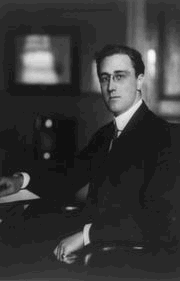
Roosevelt as Governor of New York
He returned for his twenty-fifth reunion in June 1929. His classmates had elected him chief marshal of Commencement. Harvard’s Phi Beta Kappa chapter, to which TR had belonged, chose him as orator at the annual Literary Exercises, and made him an honorary member (along with his uncle Frederick Delano, A.B. 1885, twice an Overseer and later president of the Harvard Alumni Association). Helped to his seat on the Sanders Theatre stage by his son James, then a rising senior, FDR was given a lengthy standing ovation when he stood up to speak. His address was titled “The Age of Social Consciousness.” It blended a hopeful meliorism with the complacencies of a generation that would soon be wondering how things got so bad so fast:
Fifty years ago we humans were still divided by an undoubtedly existent class consciousness. It is not so long ago that our own Harvard catalogues listed the young gentlemen those with “Esquire” after their names, and those with the mere prefix “Mister.” I incline to the phrase “the age of social consciousness” as most fitting the trend of our own day. It best describes the change in the social relationships.
The Kansas farmer and the New York mechanic send their sons and daughters to college; there is a motorcar for one out of every four of the inhabitants of the United States; proper sanitation, excellent transportation, electric light, music, arts, books by the million, the news of the day, good clothing, ready-made food-all these are literally at the command of the majority of our citizens. The luxuries of the past generation have become the necessities of the present; in creature comforts, the making easy of daily household tasks, we have gained more in 50 years than in the previous five centuries.
At Commencement President Lowell awarded 1,957 degrees in course-a record number-and 12 degrees honoris causa. The citation accompanying FDR’s LL.D. degree read, “Governor of New York; a statesman in whom is no guile.” It was a curious way to describe a man later known for his genial deviousness, love of subterfuge, and administrative legerdemain. 5 At the afternoon exercises of the Alumni Association, FDR presented the class gift of $150,000 and was one of five speakers. His theme was the need to shift the focus of higher education from “teaching directed to cooperative and mass effort” to “the stimulation and strengthening of the will and the power of the individual to act as an individual.” To many of his hearers, that must have sounded oddly like Republican ideology.
The stock market crashed in October 1929, wiping out $40 billion in stock prices, ending the Harding-Coolidge era of “normalcy,” and dooming the presidency of Herbert Hoover. In 1930 FDR was reelected governor by a record plurality. His victory made him the most logical Democratic nominee in 1932.
His adversaries at that year’s convention included Al Smith, who had come to resent his past ally, and pundit Walter Lippmann ’10, who tried to derail FDR’s nomination in his syndicated column. Though he had urged FDR to run for governor in 1928, Lippmann now called him “an amiable boy scout,” “a pleasant man who, without any important qualifications, would very much like to be President.” Among FDR’s backers was Joseph P. Kennedy ’12, a millionaire real-estate speculator whose large family included a 15-year-old son, John Fitzgerald, who would follow his father to Harvard and later become the nation’s thirty-fifth president. Joe Kennedy’s machinations got the California delegation into the Roosevelt camp. Other states fell in line, and FDR was nominated on the fourth ballot. Breaking with tradition, he flew to Chicago to accept the nomination, promising “a new deal for the American people.”
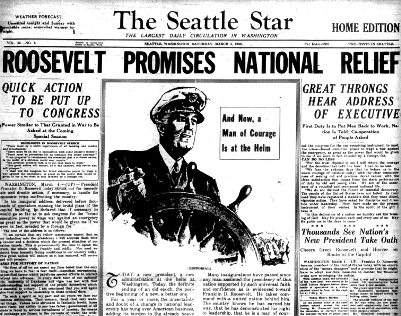
FDR’s energetic campaigning and vibrant optimism raised the nation’s morale even as the depression worsened. In October Lippmann did a volte-face, advising his readers that he would “vote cheerfully for Governor Roosevelt.” Ted Roosevelt Jr., who had come of age in the White House and yearned to reclaim it, stuck to his Republican guns. He endorsed the reelection of Hoover and told his mother that he was “distinctly hopeful about November. Franklin is such poor stuff it seems improbable that he should be elected President.” In November Ted’s distant cousin carried all but six states and his alma mater. The electorate gave FDR 23 million votes to Hoover’s 16 million. Harvard students went strongly for Hoover, a Stanford grad, in the Crimson’s straw vote. Even Norman Thomas, making the second of six presidential bids as the candidate of the Socialist Party, outran FDR in five of the seven undergraduate Houses.
Harvard undergraduates not only failed to support him; they teased him. FDR was inaugurated on March 4, 1933. Within days he received a letter written on Lowell House stationery. It stated that the House committee, with the approval of House master Julian Coolidge and President Lowell, was seeking permission to designate a “heretofore unnamed carillon of Russian Bells, at present installed in the tower of our House” as the Franklin Delano Roosevelt Bells. The bells were real. The rest was a hoax (see “The Conning of the President,” Harvard Magazine, March-April 1995, page 50). FDR wrote an appreciative note to Coolidge, who had been one of his teachers at Groton. Coolidge shot back an embarrassed “letter of humble apology” explaining that the letter was fraudulent.
Affably recalling the first class that Coolidge had taught at Groton, he went on to add, “You…announced to the class that a straight line is the shortest distance between two points-and then tried to draw one. All I can say is that I, too, have never been able to draw a straight line. I am sure you shared my joy when Einstein proved there ain’t no such thing as a straight line.” FDR, who had a taste for irony, may also have had in mind writer Elmer Davis’s pre-election assessment of him as “a man who thinks that the shortest distance between two points is not a straight line but a corkscrew.”
The new president was the first to bank heavily on scholarly expertise. “The country is being run by a group of college professors,” groused West Virginia senator Henry Hatfield. “This Brain Trust is endeavoring to force socialism upon the American people.” The best-known brain-trusters in FDR’s inner circle were from Columbia, but Harvard was well represented. Professor Alvin Hansen was a principal architect of New Deal economics. Adolf A. Berle Jr. ’13, a former lecturer at the Business School, was the resident expert on corporate behavior. Law School professor Felix Frankfurter, LL.B. ’06, was an adviser of long standing. He turned down FDR’s invitation to serve as solicitor general, but became known as “a one-man recruiting agency for the New Deal.” FDR later named him to the Supreme Court. Among Frankfurter’s star recruits were Benjamin Cohen, S.J.D. ’16, and Thomas (“the Cork”) Corcoran, S.J.D. ’26, two of FDR’s most effective aides.
A steady procession of Harvard visitors signed the White House guest book. Among them were the two dozen Crimson oarsmen who came to dine after a race at Annapolis in May 1935. One was Franklin D. Roosevelt Jr. ’37, number two oar of the junior varsity boat. As his guests filed in, the president greeted most of them by their first names, amazing Bill Bingham, Harvard’s director of athletics. When senior Tommy Hunter came through the line, FDR leaned from his chair to embrace him. The 96-pound cox of FDR Jr.’s boat had also been a polio patient.
The biggest Harvard bash was a presidential reception for the Class of 1904. As assistant secretary of the navy, FDR had entertained classmates on the deck of a destroyer, the U.S.S. Palmer, when they had their fifteenth reunion in New London, Connecticut. In April 1934, a month before the class’s thirtieth reunion, he opened the White House to 936 classmates, wives, and children from 26 states and five countries. The receiving line wound through the Blue Room for an hour. On the south lawn, a large marine band played Harvard songs. “The president had a genial word for everybody,” noted class secretary Edward A. Taft, “appearing for all the world as if he had never had so good a time.” A Boston Transcript writer observed before the event that the guests would be better off than the host, since “they are going to get more food out of him than he got votes out of them.”
The Transcript man had a point. most of FDR’s classmates opposed him politically, and some loathed him. The standard accusation was that he was “a traitor to his class.” The Reverend Walter Russell Bowie, FDR’s Crimson colleague, spoke of “the rancorous and almost hysterical political animus which rose against him and what he stood for among the privileged groups to which many of the Harvard graduates happened to belong. I was amazed and disgusted to hear the way men talked of him when he was at the Harvard Tercentenary.”
A. Lawrence Lowell, who had charge of the 1936 Tercentenary, expressed his own disregard for FDR in a correspondence preceding the event. Felix Frankfurter described the exchange as “incredible among cultured men and without precedent in this country.” Lowell, now Harvard’s president emeritus, begins by addressing the chief executive as “Mr. Franklin D. Roosevelt.” He refers to the upcoming Tercentenary ceremonies as an “opportunity to divorce yourself from the arduous demands of politics and political speech-making,” and suggests that “it would be well to limit all the speeches that afternoon to about 10 minutes.”
FDR wrote to Frankfurter, “I felt like replying-‘if I am invited in my capacity as a Harvard graduate I shall, of course, speak as briefly as you suggest – two minutes if you say so– but if I am invited as President to speak for the Nation, I am unable to tell you at this time what my subject will be or whether it will take five minutes or an hour.’ I suppose some people with insular minds really believe that I might make a purely political speech lasting one hour and a half. Give this your ‘ca’m jedgment’ and suggest a soft answer ‘suitable to the occasion.'”
At Frankfurter’s suggestion, FDR writes a polite note seeking assurance that he is being invited as the president of the United States. Lowell confirms that he is, adding, “In that capacity I suppose you will want to say something about what Harvard has meant to the nation,” and reiterating his suggested time limit of “10, or at most 15 minutes.”
“Damn,” writes FDR to Frankfurter. He then writes tersely to Lowell, “Thank you for your letter of April 14. You are right in thinking that I will want to say something of the significance of Harvard in relation to our national history. Very sincerely yours, Franklin D. Roosevelt.”
“I took economics courses in college for four years,” FDR shot back, “and everything I was taught was wrong.”
At the September ceremony, FDR omitted Lowell’s name from his opening salutation. He began by stating that he was speaking “in a joint and several capacity”: as president of the United States, as chairman of the United States Harvard Tercentenary Commission, and as “a son of Harvard who gladly returns to this spot where men have sought truth for 300 years.” His eloquent speech, partly written by Frankfurter, took barely ten minutes.
“It was really a great triumph,” Frankfurter wired FDR the next day. “You furnished a striking example of the civilized gentleman and also of the importance of wise sauciness.”
As he campaigned for a second term that fall, FDR made a point of the fact that his harshest critics were those whose solvency he had preserved with emergency measures in the darkest days of the depression. “Some of these people really forget how sick they were,” he said in a speech given in Chicago in October:
But I know how sick they were. I have their fever charts. I know how the knees of all our rugged individualists were trembling four years ago and how their hearts fluttered. They came to Washington in great numbers. Washington did not look like a dangerous bureaucracy to them. Oh no! It looked like an emergency hospital. All of the distinguished patients wanted two things-a quick hypodermic to end the pain and a course of treatment to cure the disease. They wanted them in a hurry; we gave them both. And now most of the patients seem to be doing very nicely. Some of them are even well enough to throw their crutches at the doctor.
FDR buried that year’s Republican opponent, Kansas governor Alfred Landon, winning all but 8 of 531 electoral votes, carrying every state but Maine and Vermont.
The nation had turned the corner, but disgruntled Harvard alumni still fussed and fumed. “I am shocked by a government which apparently treats saving as a sin and thrift as vicious,” wrote Philip James Roosevelt ’13, of the Oyster Bay branch, in his 25th reunion report. “I worry in a futile way over my children’s future in a country where honesty in public life is at a discount, courage commends itself to only a small minority and slick facility to a large majority.”
“It seems to me that what our President has been trying to do is fairly similar to what happened in Italy and Germany before and even now that they are ruled by Dictators,” wrote Franklin Taylor Clark ’12 in his class report. “May we hope that the American people awaken to this situation before it is too late.” When FDR proposed to enlarge the Supreme Court to ensure a pro-New Deal majority, Walter Lippmann wrote that he was “drunk with power” and was attempting to “establish the political framework for, and to destroy the safeguards against, a dictator.” 6
In 1940, with war in the offing, FDR agreed to run for an unprecedented third term. In November he decisively defeated Wendell Willkie, a liberal Republican. The prospect of more central planning did not cheer Arthur Ballantine ’04, onetime Class Orator and Crimson hand, who had been an undersecretary of the treasury in the Hoover administration. It was too bad, he told reporters, that Franklin hadn’t taken more economics and government courses at Harvard.
“I took economics courses in college for four years,” FDR shot back, “and everything I was taught was wrong. 7
FDR did have staunch friends in the Harvard family. Loyalists in the legal and financial communities included Langdon Marvin, 1898, and Grenville Clark ’03, LL.B. ’06, who once had been FDR’s law partners. Lamont and Marvin were Harvard Overseers, and Clark was a member of the Corporation. President James Conant admired FDR’s leadership and was one of his key wartime science advisers. But even Conant could share a caustic comment or two with A. Calvert Smith ’14, his right-hand man during the war years. With Conant away, Smith coordinated the secret planning for the convocation honoring British prime minister Winston Churchill with an LL.D. in September 1943. Confidential memos–in which Churchill is always “Mr. X”–make it clear that the planners hoped FDR wouldn’t choose to take part. In one memo Smith refers warily to “Mr. X and his good friend Mr. Y.” In another he asks, “Are Mrs. and Miss X coming?…Is the other Mr. Big coming?” Routing FDR correspondence to Conant, Smith attaches a slip with a typed message: “Oh! Oh! You’d better hold your watch with one hand and your wallet with the other! A.C.S.” 8
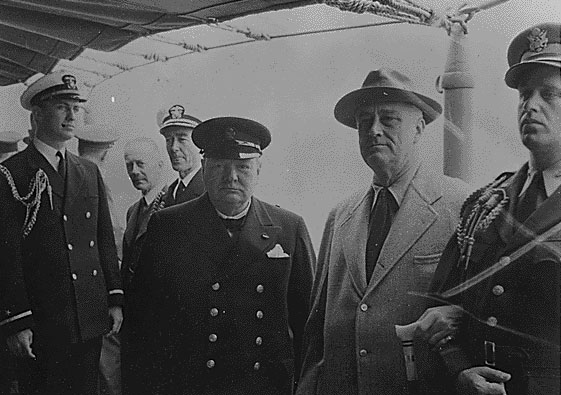
FDR and Churchill at the Atlantic Conference, 1941
Harvard class reports might be peppered with denunciations of FDR, but there were also statements like that of Ralph Lowell ’12, Lawrence Lowell’s cousin and a Republican: “I am not one of those who feel our country is headed for disaster under our present government. Rather, I believe that all changes now taking place, all smashing of traditions, all the criticism hurled at the so-called ‘malefactors of great wealth,’ ‘defeatist lawyers,’ and ‘economic royalists’ are merely episodes in the progress of a young and virile nation towards the goal of real greatness.”
The War years brought out FDR’s greatness as a national leader. His fighting spirit fitted him for the role of commander-in-chief. His eloquence gave heart to Americans and their allies in Europe and Asia. He led in forging a global alliance of nations against the Axis. In spite of his disability he became the first president to leave the country in wartime, traveling to meetings in Canada, North Africa, Iran, Hawaii, Malta, Egypt, and Russia with heads of state and military commanders. And he labored to plan a durable peace.
In 1944, with the end of the fighting in Europe in sight, he ran for a fourth term against New York governor Thomas E. Dewey and was resoundingly reelected. Though his personal physician had officially judged him fit, FDR was ill. He was being treated for hypertension and congestive heart disease, exacerbated by forty years of smoking. Frank Lahey, M.D. ’04, a consulting physician, may also have detected an inoperable stomach tumor that had metastasized from a facial melanoma. FDR’s color was poor; he looked gaunt, haggard, and much older than 62. But he could still reach back for a burst of energy when he needed it. In a New York City motorcade in October he rode for hours in an open car as cold rain fell. A speech to the Teamsters Union in Washington-his “Fala speech”-had virtually clinched his election:
These Republican leaders have not been content with attacks on me, or my wife, or my sons. No, not content with that, they now include my little dog, Fala. Well, of course, I don’t resent attacks, and my family doesn’t resent attacks, but Fala does resent them. You know, Fala is Scotch, and being a Scottie, as soon as he learned that the Republican fiction writers in Congress and out had concocted a story that I had left him behind on the Aleutian Islands and had sent a destroyer back to find him-at a cost to the taxpayers of two or three, or eight or twenty million dollars-his Scottish soul was furious. He has not been the same dog since. I am accustomed to hearing malicious falsehoods about myself but I think I have a right to resent, to object to libelous statements about my dog.
His participation in the Yalta conference, held at a Black Sea port in February 1945, left him physically depleted. His hands now shook alarmingly. In April he went to his winter home in Warm Springs, Georgia, to rest before going to San Francisco for a conference inaugurating the United Nations. Before lunch on April 12 he was reading the day’s mail while having his portrait painted. He had dressed for the portrait in a double-breasted suit and Harvard tie. The artist, Elizabeth Shoumatoff, recalled that he looked “surprisingly well.” Suddenly FDR collapsed, putting his hand to his head and saying he had “a terrific pain.”
After two hours of tortured breathing he died of a massive cerebral hemorrhage. The news went out on national radio just before six. It crackled around the world almost instantaneously, arousing shock and consternation everywhere. In London the hour was midnight; the British Broadcasting Company’s bulletin called it “the darkest night of the war.”
FDR had just finished drafting a Jefferson Day address to be given the next day. The last words he had written were, “The only limit to our realization of tomorrow will be our doubts of today. Let us move forward with strong and active faith.”
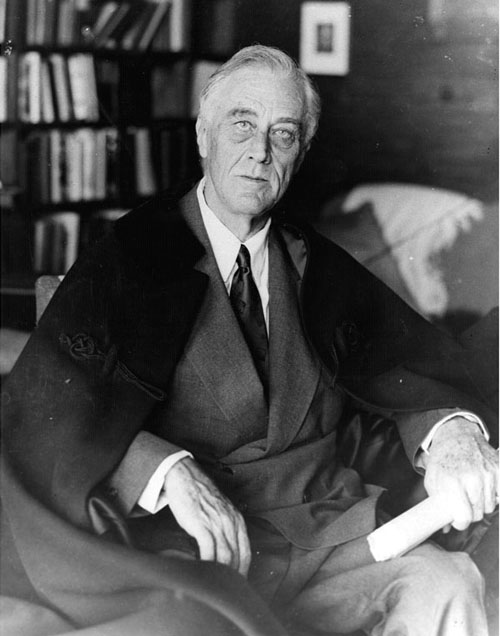
This haunting picture, taken in Warm Springs the day before FDR died, shows the ravages caused by 13 years in the Presidency.
Anticipating the end, Walter Lippmann had devoted his column of April 7 to FDR. “His estimate of the vital interests of the United States has been accurate and far-sighted,” Lippmann wrote. “He has served these interests with audacity and patience, shrewdly and with calculation, and he has led this country out of the greatest peril in which it has ever been to the highest point of security, influence, and respect which it has ever attained.”
At the Harvard memorial service, Dean Willard Sperry spoke of the tragic timing of the president’s death: “He died too soon. He had earned the right to see victory on land and sea and in the air. He should have seen it for himself; his eyes should have beheld it, and not another.” An Alumni Bulletin editorial noted that “Mr. Roosevelt, as he grew older, grew into younger hearts. He was a symbol, a cause, a reason, and an anvil of strength to youth. He was the only President this fighting generation had ever consciously known. It knew him well. He foresaw; and he acted as none but the prescient can act. That is something which youth is supremely fitted to understand. ‘He belonged to this day,’ as Dr. Sperry so wisely said. ‘He spoke the language of the hour and needed no interpreter.'”
As a loyal member of his class, FDR always complied when the class report office requested personal information and opinions. His handwritten answers were conspicuous for their brevity. “I have traveled in almost every state in the Union,” he wrote in 1934, “and written several tons of speeches, articles, and radio addresses. Convictions? Yes, lots.”
This is how he answered a 1939 questionnaire:
Your business or professional associations: Same.
What traveling have you done? About 1,000,000 miles.
What classmates do you frequently hear from or see? Flocks.
What have you written, edited, compiled, translated, or composed? Altogether too much.
What public service have you performed? President, U.S.
In his class’s fiftieth reunion report, in 1954, Lathrop Brown devoted his entry to the qualities that sustained his former roommate in the earliest days of his presidency and beyond:
In a few weeks the nation was lifted from the pit of despair to the high ground of confidence. It was no small thing that within one man could be contained enough of faith to restore the lost morale of a great nation. All over the world were the stirrings of the lesser people of the world. England, France, Italy, Germany, and Spain fell prey to totalitarianism, socialism, fascism, or chaos. Under Franklin there was no revolution. The value of the dollar fell, but the value of the “forgotten man” rose to its full measure of dignity and decency. Franklin’s ethics, learned at home, at school, at college, and in his church at Hyde Park, gave him a sure sense of direction; and gave him enough of faith to lead the nation.
Footnotes
1. This assessment appears in Geoffrey Ward’s Before the Trumpet (Harper & Row, 1984), an invaluable source of material for this article. Other good accounts of Roosevelt’s youth include Franklin D. Roosevelt: The Apprenticeship (Little, Brown, 1952), by the late Frank Freidel, and Kenneth S. Davis’s FDR: The Beckoning of Destiny (Putnam, 1971). Broader in scope, but easy reading, is Collier and Horowitz’s The Roosevelts: An American Saga (Simon & Schuster, 1994), which traces the contrapuntal relationship of the Hyde Park and Oyster Bay branches of the Roosevelt family.
2. Frank had been tagged with mean nicknames before. The acerbic Alice Roosevelt Longworth, TR’s eldest child, recalled that young wags in the Oyster Bay clan referred to their cousin F.D. as “Feather Duster,” “the handkerchief-box young man” (because he resembled the prettified boys portrayed on such boxes), and “Miss Nancy” (because he “pranced around and fluttered” on the tennis court). When he became an officer of the Crimson, an in-house poster introduced him as “Rosey Rosenvelt, the Lillie of the Valley.”
3. Unlike TR, he failed two courses in his first year there. He took make-up exams, passed the bar exam after his second year, and did not return for a third year of study. Some of his teachers made a point of remembering that.
4. Then 84, Dr. Keen had been hailed as “the dean of American surgery” when Harvard awarded him an honorary degree in 1920. He had been a surgical officer in the Civil War, the Spanish-American War, and World War I.
5. Yale did much better by FDR. When he received an LL.D. there in 1934, the citation read, “Brave leader of your people in a time of peril; with indomitable courage and good cheer, with patience and good humor, you have brought high intelligence and complete devotion to the service of the nation, winning to your personal allegiance millions of men of every creed and party.” Presenting the honorand, Professor William Lyon Phelps stated that he had “done more to make the front pages of the newspapers interesting than any other peacetime President,” and observed slyly, “He is well named. He has the energy of Roosevelt with the charm of Franklin.”
6. Lippmann, who blew hot and cold on FDR, had told him in February 1933, “The situation is critical, Franklin. You may have no alternative but to assume dictatorial powers.” (see Ronald Steel, Walter Lippmann and the American Century, Atlantic-Little, Brown, 1980, page 300.)
7. FDR’s personal recollections were inexact. He did not take economics for four years; he did take one economics course in his second year of college and three in his fourth year. He took one government course in his first year and two more in his third.
8. In the even, the president chose to stay in Washington. As his guest there for much of the summer, Churchill had kept his usual late hours and put FDR’s staying power to a stiff test.
